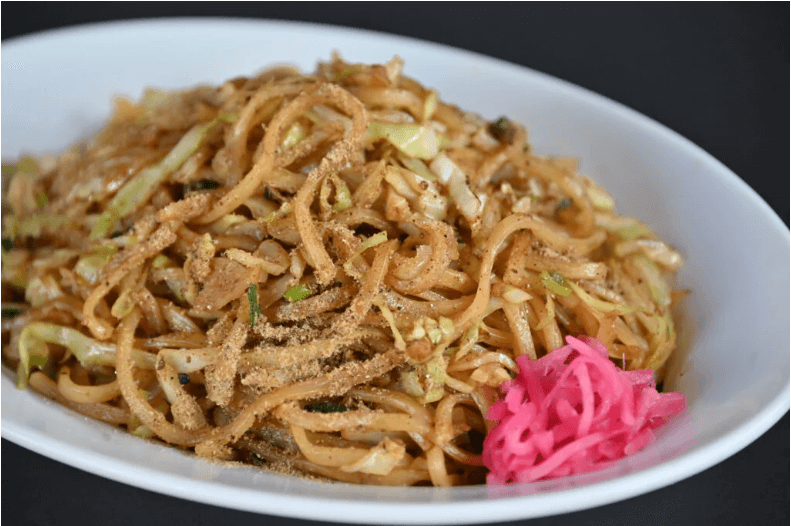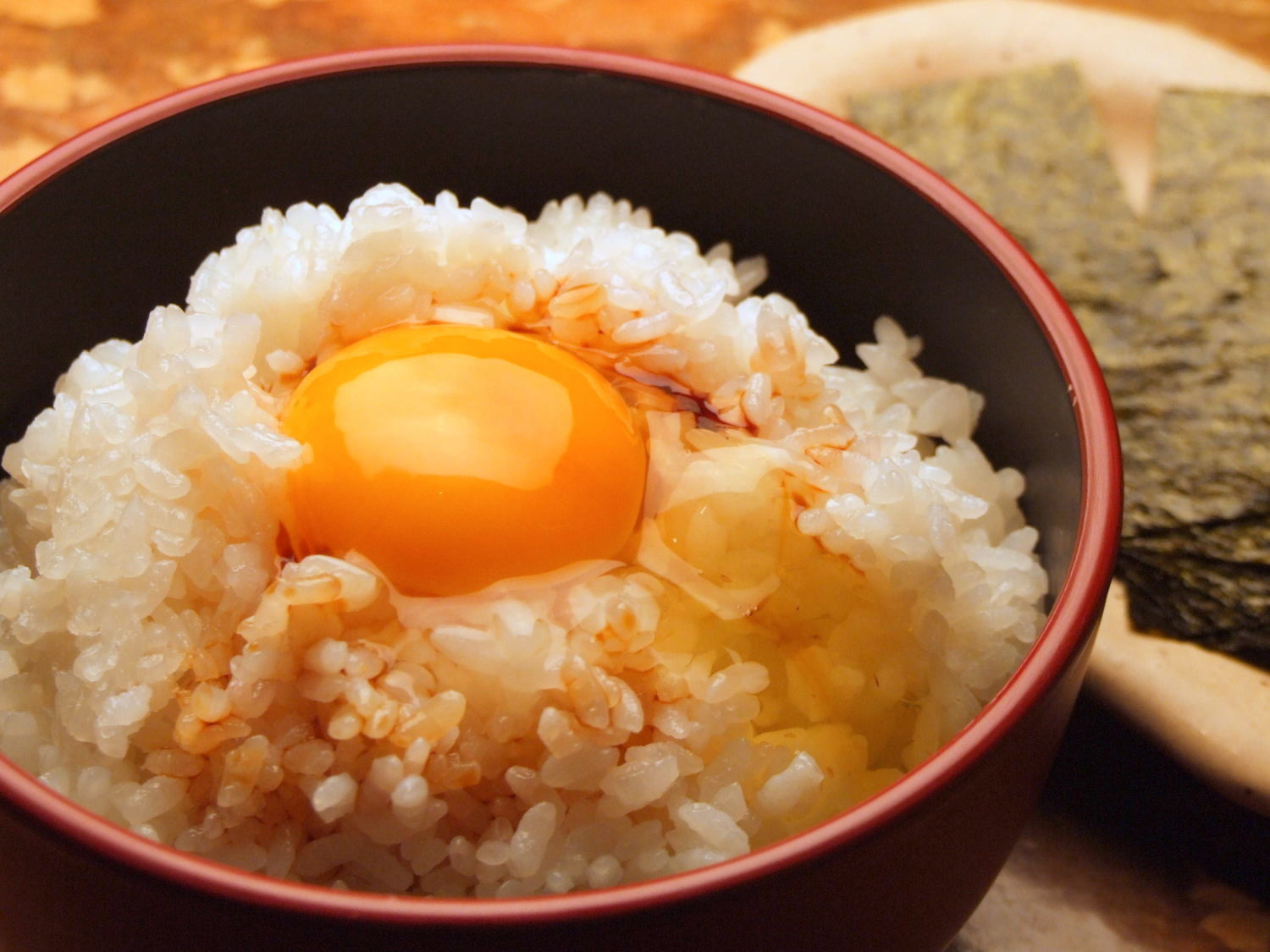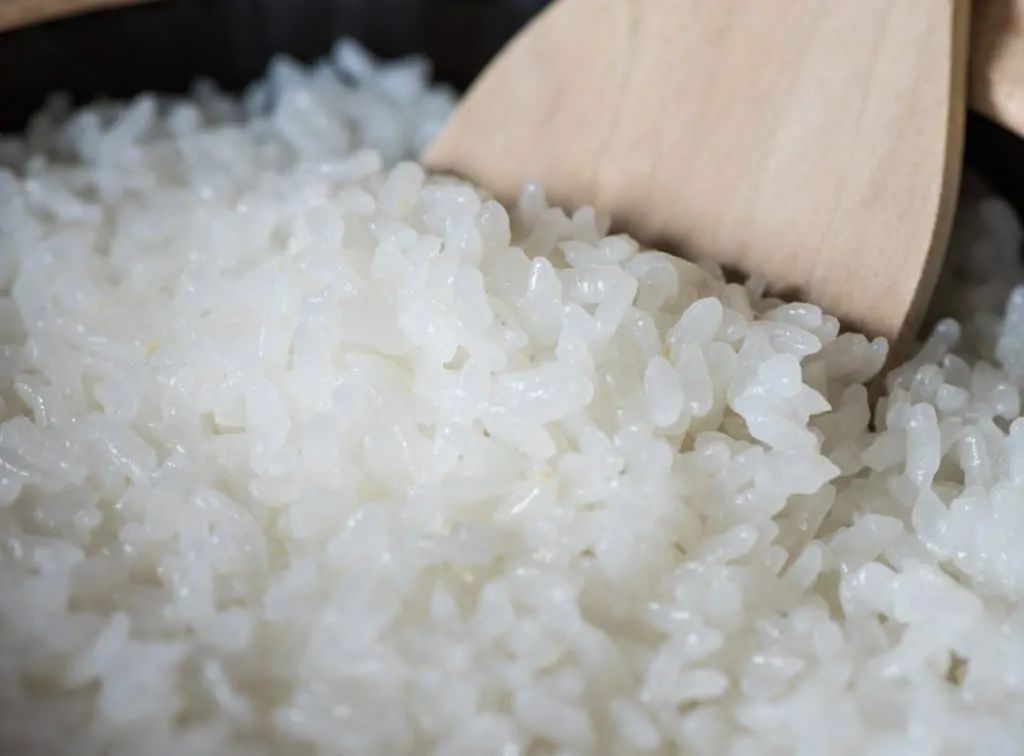
Rice is the most common, and probably the most important ingredient in Japanese cuisine. Traditionally, it can be eaten for breakfast, lunch, AND dinner.
Despite its importance, many people overlook the simple task of cooking rice.
In this article I take a look at how to cook rice with a rice cooker.
It may seem like common sense to some, but if you have never used one before, a rice cooker can seem like an unnecessarily complicated contraption:
How much water should I use? Do I have to wash the rice first? How many times? How long does it cook for? How do I get fluffy, beautiful rice like in restaurants??
Don’t worry, all your questions and more will be answered below. Once you learn how to use a rice cooker, you will be able to make perfectly cooked rice every single time.
We will go over a couple methods:
- the quick/lazy way;
- and the proper, authentic, very thorough Japanese way.
How to cook rice with a rice cooker – Prerequisites
First, let’s take a look at what we need before we get started.
- Rice! Ideally, Japanese short grain rice; or medium grain if you can’t find short grain. Different types of rice will cook at different speeds, and may require different levels of water etc. See notes at end of article for more info.
- A rice cooker. Any electric rice cooker will do for now. You may get slightly different results depending on your specific rice cooker, so you will need to adjust accordingly after some trial and error
- A rice measuring cup. Hopefully, your rice cooker came with a measuring cup. A standard Japanese rice measuring cup (i.e. 1 合) has a volume of 180mL, and will weight out 150g of rice (regular white rice).
- A large mixing bowl. For washing the rice. You could also use the inner pot of the rice cooker if you don’t mind.
- Clean water. To wash your rice. Tap water is fine, although it is recommended to use purified / filtered water if possible.
The quick and lazy way
This is how I typically cook rice when I don’t have time, or am in a bit of a rush to get everything done. Let’s say I want to cook three cups of rice.
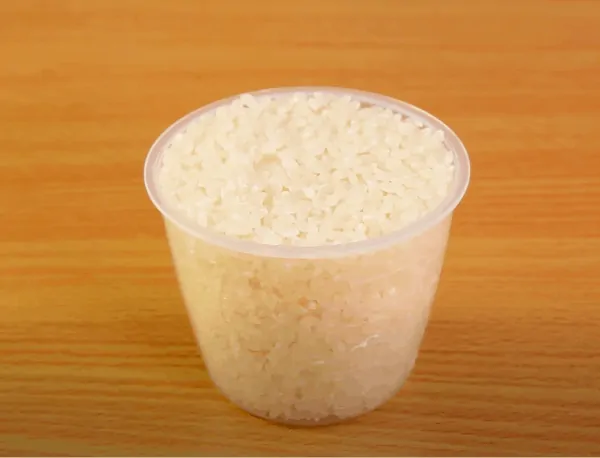
Step 1
Measure out three cups of rice using the provided rice measuring cup, and put it in a mixing bowl (or directly in the removable pot of the rice cooker).

Step 2
Add clean water, stir around with with your hand, and then drain the water. Repeat 3-4 times until the water is almost clear (it should still be a little cloudy looking). Drain one last time.
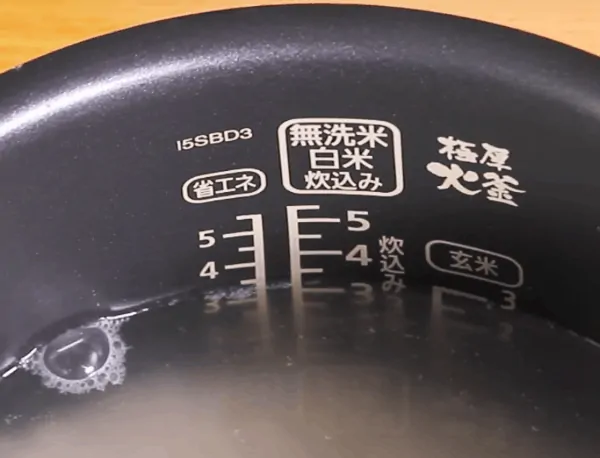
Step 3
Transfer rice to the rice cooker pot. Pour in clean water up to the 3 cup line marking (or however many cups you are cooking). If you have no markings on your rice cooker, you need to eyeball it, or measure out 600mL of water (i.e. 200mL of water for every 150g/180mL cup of rice).
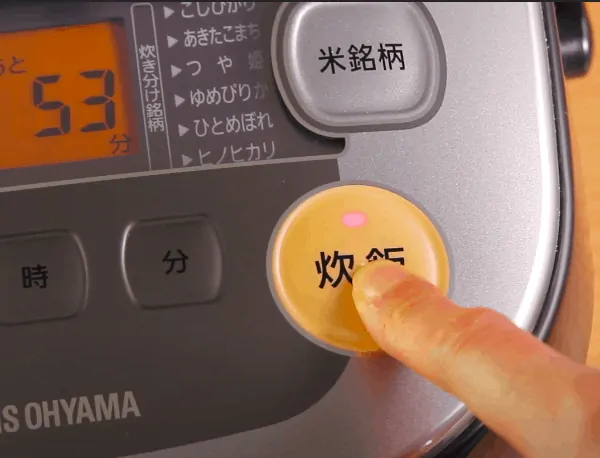
Step 4
Place pot back into rice cooker, and press cook (炊飯)!
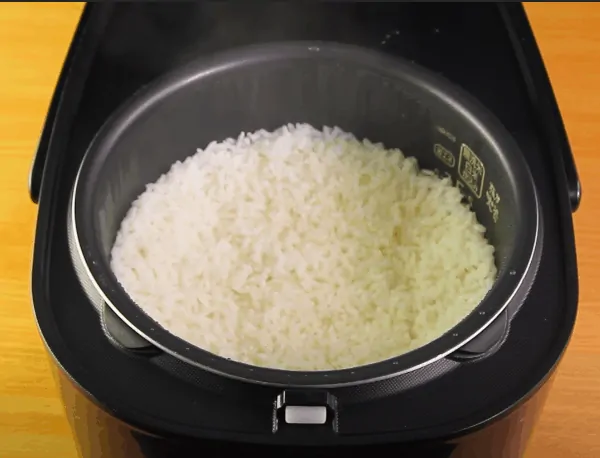
Step 5
Wait 20 minutes or so, and your rice is done! Enjoy 🙂
The proper Japanese way
Now, let’s look at the real, proper Japanese way to cook rice with a rice cooker. It is similar to the lazy way, but with a few extra steps and detail that will help make your rice come out perfect every time.
Step 1: Measure your rice
Precisely measure out the amount of rice you want to cook with your rice cooker’s provided measuring cup. If you have a scale, one cup of rice should be 150g.
If you don’t have a scale, fill the cup past the top, then level it off with a chopstick (or your finger) like the image below. Measuring precisely will help you produce consistent results every time.

Put each measured cup of rice into a large mixing bowl to prepare for the next step (washing). You can also put it directly into the inner pot of the rice cooker, although some people think that doing this will scratch the pot (which is usually made of teflon).
Important note: A cup for measuring rice is slightly smaller than a typical measuring cup for cooking. A rice measuring cup is 180mL (equal to 1合 “gou” in Japanese), while a measuring cup for cooking is usually 200mL or more (depending on which country you’re from).
Step 2: Wash your rice, Part 1 – Quick rinse
Quickly dump plenty of clean water into the rice bowl all at once (or conversely dump the rice into a large bowl of water). If you are adding water directly from the tap, turn the tap on full strength, so the water comes out fast. Also, remember to use cold water!
Stir the rice around a few times quickly with your fingers, then immediately drain the water out. Pour the water out carefully so that the rice does not spill out.

Using a finely meshed colander makes this process a bit easier / faster:

Repeat this process 1-2 more times.
The purpose of this first wash is to remove the rice bran smell and prevent it from being absorbed into the rice. It also helps removes dust and dirt. The water needs to be dumped in and removed quickly, so that the rice does not have time to absorb the rice bran odour while soaking.
Step 3: Wash your rice, part 2 – “Sharpening” your rice (米を研ぐ)
With your hand in a claw, stir the drained rice in a circular motion 10-20 times. This is known as “sharpening” or polishing your rice.

After stirring, pour in some clean water, and mix gently a couple more times. The water should be very cloudy/milky looking at this point. Drain out the water.

Add water, mix, and drain again 2-3 more times until the water is only slightly cloudy, and you can easily see the rice below (water does not have to be 100% clear). Rinsing too many times will remove all the flavor and nutrition from the rice.
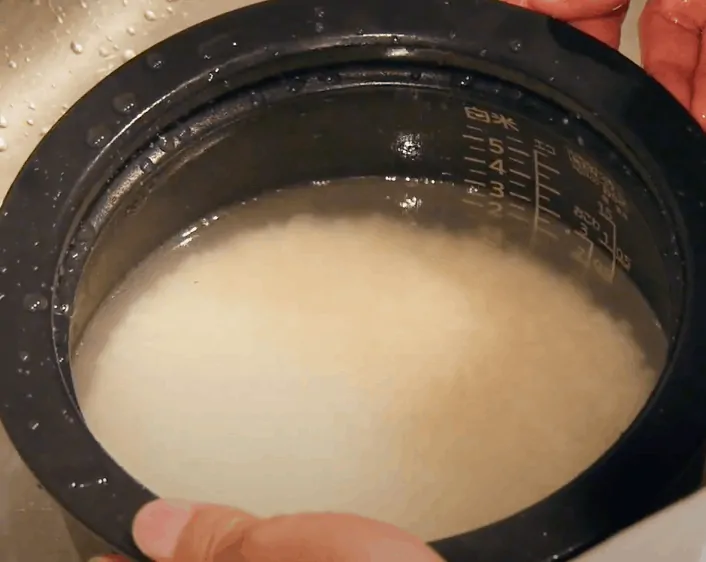
What’s with all this washing/mixing? Washing Japanese white rice is more than just for cleaning purposes. In addition to removing dust and dirt particles from the surface of the rice, washing (or “sharpening”) helps rub off any additional rice bran that might still be attached to the surface. The reason to mix without water in this step is to increase the friction between the individual grains of rice (helping remove rice bran better). Washing also removes excess surface starch which will cause your rice to be goopy and stick together when cooked.
What the hell is rice bran? Rice bran is the byproduct of milling brown rice into white rice. Although nutritious and full of vitamins, rice bran has a unique odor (ぬかの臭い) that is typically unwanted when eating white rice. These days, white rice comes with most of the rice bran already removed, so it is not as rigorous a process as before. Rice bran is used for other purposes like making rice bran oil, or pickling (糠漬け). Apparently, bears also like the smell of rice bran, and often raid storage houses.
Step 4: Measure water
Transfer the drained rice into your rice cooker pot, then pour in the appropriate amount of water to be used for cooking your rice. Again, use purified or filtered water for better taste.
How much water should you use?
Many rice cookers will have a line on the inside of the pot to indicate where to fill water based on how many cups of rice you are cooking.
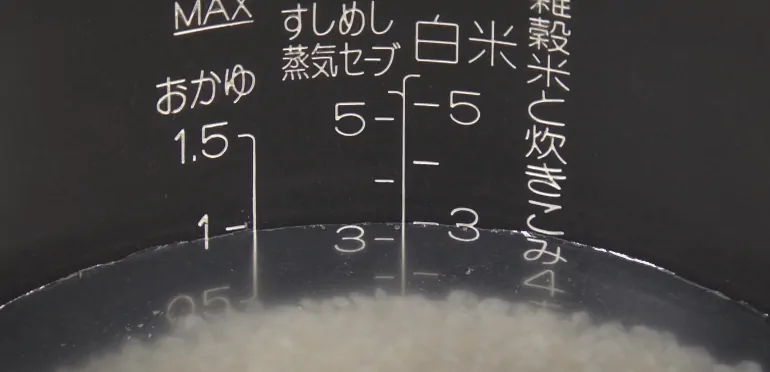
If your cooker does not have these lines, you will need to measure out the water yourself. For each cup of rice (180mL / 150g), you should use 200mL (200g) of water. So, if you are cooking two cups of rice, then you should use 400mL of water. If you are cooking three cups of rice, you should use 600mL of water, and so on.
Tip: Make sure you are on a level surface when adding water so your reading is accurate
Step 5: Soaking
Allow the rice to soak in the water for 30 minutes to up to 2 hours. Soaking time depends on temperature. So, in the summer/spring, or when the temperature is warmer, you only need to soak for 30 minutes. In colder weather (autumn/fall), allow 1-2 hours of soaking time.
Why do you need to soak the rice? Soaking allows the rice to fully absorb water before cooking process. This helps each grain of rice cook evenly and results in plump, fluffy, beautiful, delicious rice.
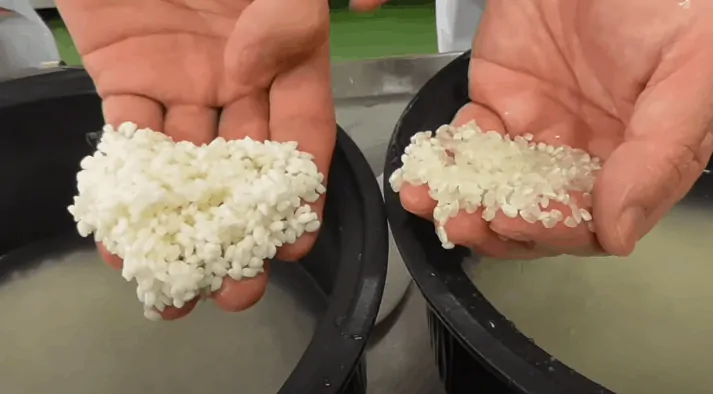
If you do not soak, you risk having the inner core of the rice be harder than the outside. Some more advanced rice cookers will automatically consider the soaking time, so you may be able to skip this step.
Step 6: Cook the rice!
Finally! Turn the rice cooker on, and press the cook button! If you have a Japanese rice cooker, it may have these characters on the button: “炊飯” (sui-han – i.e. “cook rice”), or “スタート” (sutaato – i.e. “start”).
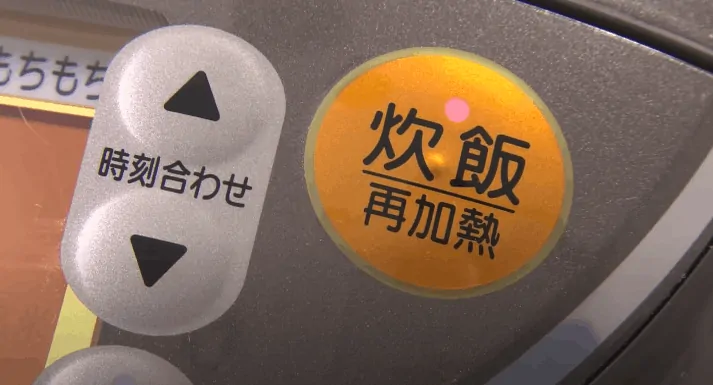
Now, sit back and wait until the rice cooker is finished. Cooking time will depend on how much rice you are cooking, and also your rice cooker. It may take anywhere from 15 – 60 minutes to finish cooking.
When cooking is finished, your rice cooker will automatically stop and notify you. Either a button will pop up, a light will change color, or it may even play a sound to notify you.
Step 7: Mix/Loosen the rice
Once the rice is cooked, immediately loosen and gently mix the rice. Split the rice into quarters, flip each quarter upside down, and gently spread apart the rice. This allows the rice to be evenly cooked. If you do not do this, the rice at the bottom of the pot will heat/cook more, and may become burnt or hard. Remember to mix the rice gently, so you don’t crush the individual grains.

It is also a good idea to wipe any moisture off the lid of the rice cooker, as the droplets of water may fall onto the rice, causing some sections to cook unevenly.
Step 8: Eat!
Enjoy your perfectly cooked Japanese rice 🙂
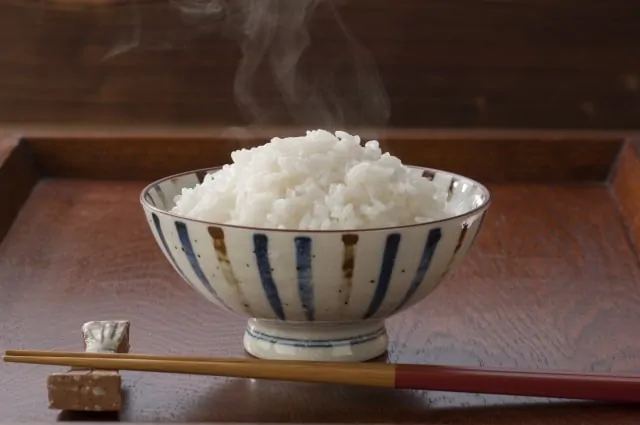
Other Notes
Here are some more interesting notes/facts to further your understanding of cooking rice.
Rice cooker water to rice ratio
The most important part to remember of cooking rice with a rice cooker is the water to rice ratio. For typical Japanese short grain white rice, the ratio of water to rice is:
- By weight: 200g water to 150g rice (4:3 ratio)
- By volume: 200mL water to 180mL rice (10:9 ratio)
If you are lazy, you could just also use a 1:1 ratio (by volume), as it is pretty close. The finished rice will be firmer, but perhaps you like it better that way. If you want softer/mushier rice, then you can add a bit more water next time.
Rice cooker water to rice ratio will also differ if you are cooking brown rice (or other types), and the freshness of rice. Typically, brown rice needs a lot more water. If your rice is very old, it will be drier, so you will also need a bit more water than usual.
Storing / Leftover rice
What do you do if you cooked too much rice? With some higher end rice cookers, you can just leave your rice inside the pot with the “keep warm” option, and it will stay fresh for a very long time. After some time though, the rice will eventually turn yellow, dry out, and turn slimy. If you have a lot of extra rice leftover there are a couple things you can do.
- The typical Japanese way is to portion the rice out individually while it is still warm, wrap each portion in plastic wrap, then put the portions in the freezer. The frozen rice packets will last for about one month. When you are hungry, just thaw a portion, or pop it into the microwave, and you have tasty (almost fresh) rice.
- Or, put the rice in a container with lid and store it in the fridge for one or two days. The rice will dry out a bit, which makes it perfect for fried rice (i.e. yakimeshi) 🙂
About water
If you want extra delicious rice, use filtered/purified water instead of plain tap water, as the rice will absorb some of the water during the process (especially when the rice is dry). If you use tap water — depending on where you live — it may have a chlorine taste / smell which will also be absorbed by the rice when washing/soaking and cooking. Whatever water you choose, DO NOT use hot water!
If you wash soak the rice in hot water, the surface temperature of rice rises which causes it to absorb the unwanted rice bran odour. It will also cause the rice to cook unevenly, resulting in the surface of the rice grains becoming too soft/mushy.
How to cook brown rice in a rice cooker?
Some people prefer brown rice for its nutritious properties. The process is the same as above with a few differences. You can skip “Step 3 (sharpening)”, as the main purpose of that step is to remove the excess rice bran from milling (i.e. turning brown rice to white rice). Instead, just wash and drain quickly 2-3 times to remove dust and dirt.
You will also need to use more water. The general rule for brown rice is to use 1.5x more water than rice (by volume). So, if you are cooking 1 cup of rice, put 1.5 cups of water.
Lastly, you need to soak the rice longer. It is recommended to soak for at least 6-7 hours (!!). Brown rice has the outer shell on it, so it takes a long time to absorb water. You can do it overnight (keep the rice in the fridge to prevent bacteria growth). If you don’t soak the rice, it will end up being hard/dry after cooking.
Some rice cookers will have a special brown rice setting. In that case, follow the instructions for your rice cooker.
What about “no-wash” rice?
These days, there is also “no-wash” rice on the market. You can skip the washing (steps 2 and 3), but I would still give it a quick rinse. You will also need to use more water. Try to use 1.5x the weight of rice. So, for every cup of rice (150g), use 225g (mL) of water.
How much rice to cook per person?
That of course depends on how much you eat. I can probably eat one cup of rice myself, but normally I think it is about 1/2 – 3/4 cups per person.
What to do with leftover rice water?
It kind of seems like a waste to rinse and dump away so much water. Can you reuse this rice water somehow? I found some ways.
Conclusion
Now you know how to cook rice with a rice cooker — the proper way, and the lazy way.
There are a lot of small details that can easily be overlooked when cooking rice. By following the proper methods — and a with bit of experience — you will be able to cook perfect, fluffy rice every time.
I learned a lot of new things while researching this article despite having used a rice cooker my entire life. I hope that this was helpful and insightful to you as well.
How are your rice cooking skills? Let me know in the comments at the bottom of the page!
If you are looking to buy a new rice cooker, make sure to check out the Best Japanese Rice Cooker article next!
Sources:
https://park.ajinomoto.co.jp/recipe/basic/cookrice/
https://washoku-no-umami.jp/gohannotakikata#1
https://www.sirogohan.com/recipe/suihan-taku/
https://www.akafuji.co.jp/andjapanrice/english/knowledge/01.html
Youtube 1 / 2 / 3
Subscribe for free today! Receive cool recipes, my latest Japanese knife picks and learn about Japanese culture. Delivered every other week to your inbox.
